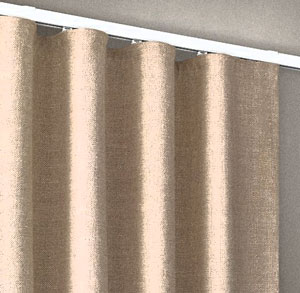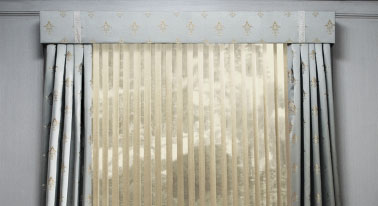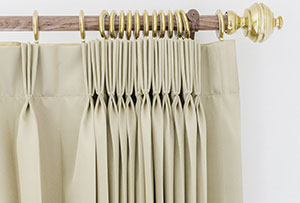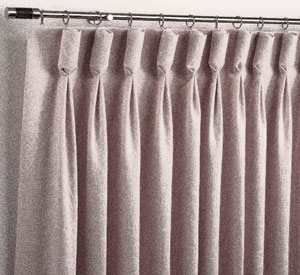If you’ve ever spent time looking at pleated drapery panels, you won’t be surprised by what we’re about to tell you. (If you haven’t, we want you to be prepared when you start your search!) Here it is: Pleated drapes are complicated.
We know, we know — that sounds obvious coming from us. But it’s true! Each style has its own personality. There’s not just one way to create pleated drapery panels, or one kind of pleat. More than once, a client searching for pleated drapes has come to us frustrated and confused. In this post, we demystify pleated drapes by introducing the four most popular pleated drapery styles: what they’re called, what they look like, and why people love them. (You can thank us later.)

1) “Ripple Fold” Pleated Drapes
Ripple fold pleated drapery panels are a variation on rolled-pleat draperies. For these drapes, the curtain panel itself is flat, and the pleating is made via the spacing of the snaps.
How it’s done: The ripple pleating doesn’t come from a pleat, exactly. Instead, there are snaps on the header of the curtain that allow the fabric to pleat to a given fullness.
Why people love them: They’re modern, clean, simple, and easy to maintain. Perfect for casual draperies in contemporary-style homes.

2) “Inverted Pleat” Pleated Drapes
Inverted pleats are exactly what they sound like—typical pleated drapes in which the pleat itself has been inverted. This can be an inverted box pleat or an inverted pinch pleat. This gives depth to the drapes while allowing them to lay flatter than regular pleated drapes. Note: Inverted box pleat drapes must remain stationary, so if your drapes need to move, an inverted pinch pleat is best.
How it’s done: An inverted pinch pleat uses a loose pinch to give a concave conical silhouette. The inverted box pleat places the box on the window-facing edge, so the pleating looks flat at the top. The pleats then hang in a concave fashion.
Why people love them: Sleek and highly contemporary, these are the perfect drapes for modern interiors.

3) “Pinch Pleat” Pleated Drapes
The pinch pleat is sometimes known as the French drapery pleat, and it’s widely considered a classic—the little black dress of pleated drapes. They can be done in five different ways—from a single pinch pleat up to a five-finger pleat. (The depth and thickness of the pleat grow with the numbers.)
How it’s done: A simple pleat is placed at the top of the fabric, then pinched and tacked together, either at the bottom third or the top of the pleat.
Why people love them: They’re sleek, chic, and effortlessly traditional.

4) “Goblet Pleat” Pleated Drapes
A goblet pleat resembles a three-finger pinch pleat, but the pleat forms a wineglass silhouette. There are a number of different variations on the goblet pleat—it can be open, closed, knotted, tied, tuxedo, and rosebud, among other things.
How it’s done: The pleating is embellished with a stiffening card to form the goblet shape.
Why people love it: It adds a touch of elegance and symmetry to your pleated drapes. Perfect for a transitional home or a luxurious dining or living room.
Was your favorite pleated drapery not mentioned here? Do you need more advice on pleated drapery panels? Stop by Strickland’s showroom today to consult our in-house drapery specialist. She’ll be happy to point you in the right direction!